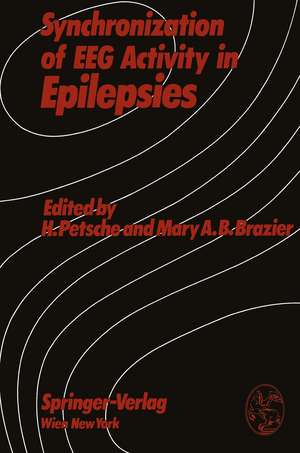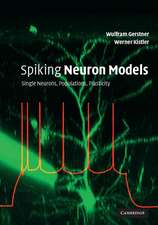Synchronization of EEG Activity in Epilepsies: A Symposium Organized by the Austrian Academy of Sciences, Vienna, Austria, September 12–13, 1971
Editat de Hellmuth Petsche, Mary A.B. Brazieren Limba Engleză Paperback – 9 ian 2012
Preț: 375.85 lei
Preț vechi: 395.63 lei
-5% Nou
Puncte Express: 564
Preț estimativ în valută:
71.92€ • 76.91$ • 59.96£
71.92€ • 76.91$ • 59.96£
Carte tipărită la comandă
Livrare economică 18 aprilie-02 mai
Preluare comenzi: 021 569.72.76
Specificații
ISBN-13: 9783709183083
ISBN-10: 3709183081
Pagini: 444
Ilustrații: X, 432 p.
Dimensiuni: 152 x 229 x 23 mm
Greutate: 0.59 kg
Ediția:Softcover reprint of the original 1st ed. 1972
Editura: SPRINGER VIENNA
Colecția Springer
Locul publicării:Vienna, Austria
ISBN-10: 3709183081
Pagini: 444
Ilustrații: X, 432 p.
Dimensiuni: 152 x 229 x 23 mm
Greutate: 0.59 kg
Ediția:Softcover reprint of the original 1st ed. 1972
Editura: SPRINGER VIENNA
Colecția Springer
Locul publicării:Vienna, Austria
Public țintă
ResearchDescriere
The onset of an epileptic seizure has become a matter of prime interest in the last two decades. For successful therapy it is of the greatest importance to understand how the different inhibitory mechanisms involved in the normally functioning brain are carried out, and how the devastating avalanche of the seizure activity may overrun wide areas of grey matter. This problem of how an attack may arise has been dealt with in several monographs, but from different points of view: on the one hand chiefly from the viewpoint of the clinical EEG (GAsTAuT et al. 1969), on the other hand from the viewpoint of experimental epilepsy, starting with the activities observed at the level of the nerve cell (JASPER et al. 1969). This volume has quite a different perspective. It contains the papers and discussions presented at a Symposium organized by the Austrian Academy of Sciences, the aim of which was to arrive at a better understanding of some of the electrical phenomena accompanying the epileptic seizure.
Cuprins
Comparison of Different Cortices as a Basis for Speculations on Their Function.- The Basic Neuronal Circuit of the Neocortex.- A Golgi Analysis of the Sensory-Motor Cortex in the Rabbit.- Invited Discussion.- Discussion to the Papers of Braitenberg, Szentágothai, and Tömböl.- Studies on Extracellular Potentials Generated by Synaptic Activity on Single Cat Motor Cortex Neurons.- Randomness and Synchrony in the Generation of the Electroencephalogram.- Neuronal Correlates of the Visual Evoked Response and Disinhibition in the Visual Cortex during Flicker Stimulation.- Relations between Cortical DC Shifts and Membrane Potential Changes of Cortical Neurons Associated with Seizure Activity.- Normal and Epileptic Synchronization at the Cortical Level in the Animal.- Discussion to the Papers of Raabe et al., Elul, Kuhnt, Speckmann et al., and Scherrer et al..- Changes of Focal Potentials by Iontophoretic Application of Glutamic Acid and Gamma-Amino-Butyric acid.- Discussion.- Pacemakers, Synchronization, and Epilepsy.- Discussion.- Experimental Research on the Ontogenetic Development of the Mechanism of Epileptic Synchronization. Comparative Study on the Immature and Mature Brain.- Discussion.- The Measurement of Synchronization.- Discussion.- Invited Discussion. The Fast Walsh Transformation: a New Method for Analysing EEG Data.- Discussion.- Temporal Distribution of Interictal and Ictal Discharges from Penicillin Foci in Cats.- Human Cortical Electrogenesis: Stratigraphy and Spectral Analysis.- Discussion.- Intracortical Aspects of the Synchronization of Self-Sustained Bioelectrical Activities.- Discussion.- Invited Discussion. Some Results of the Analysis of Epileptic Seizure Patterns by Correlation Methods.- Phylogenetic Aspects of Synchronization in the Electrogenesis of Epileptic Phenomena. Thalamo-Cortical Mechanisms in Lower Vertebrates.- Human Scalp EEG Fields: Evoked, Alpha, Sleep, and Spike-Wave Patterns.- Discussion.- Mathematical Simulations of Alpha Rhythms Recorded on the Scalp.- Discussion.- Photically Induced Epilepsy in Papio Papio: The Initiation of Discharges and the Role of the Frontal Cortex and of the Corpus Callosum.- Discussion.- Mechanisms of Cortical Discharges in “Generalized” Epilepsies in Man.- Discussion.- Generalized Spike and Wave Discharges: a Consideration of Cortical and Subcortical Mechanisms of Their Genesis and Synchronization.- Discussion.- Interactions of Deep Structures during Seizures in Man.- Discussion.- General Discussion.















